“She is on a standing bearing!”, my mate Martin screams against the wind. I am eagerly holding the steering wheels, it´s loud because the wind did increase further more and the waves – at least appeared – did as well. “Okay, ready to tack!”, I am yelling and position myself at the lower wheel. The Gedser-Rostock Ferry is quickly closing in. She is lit up like a burning chunk of magnesium. The boat is rocking in the waves when I screamed: “TACK!” as I was turning the wheel to hard starboard and the boat was going about.
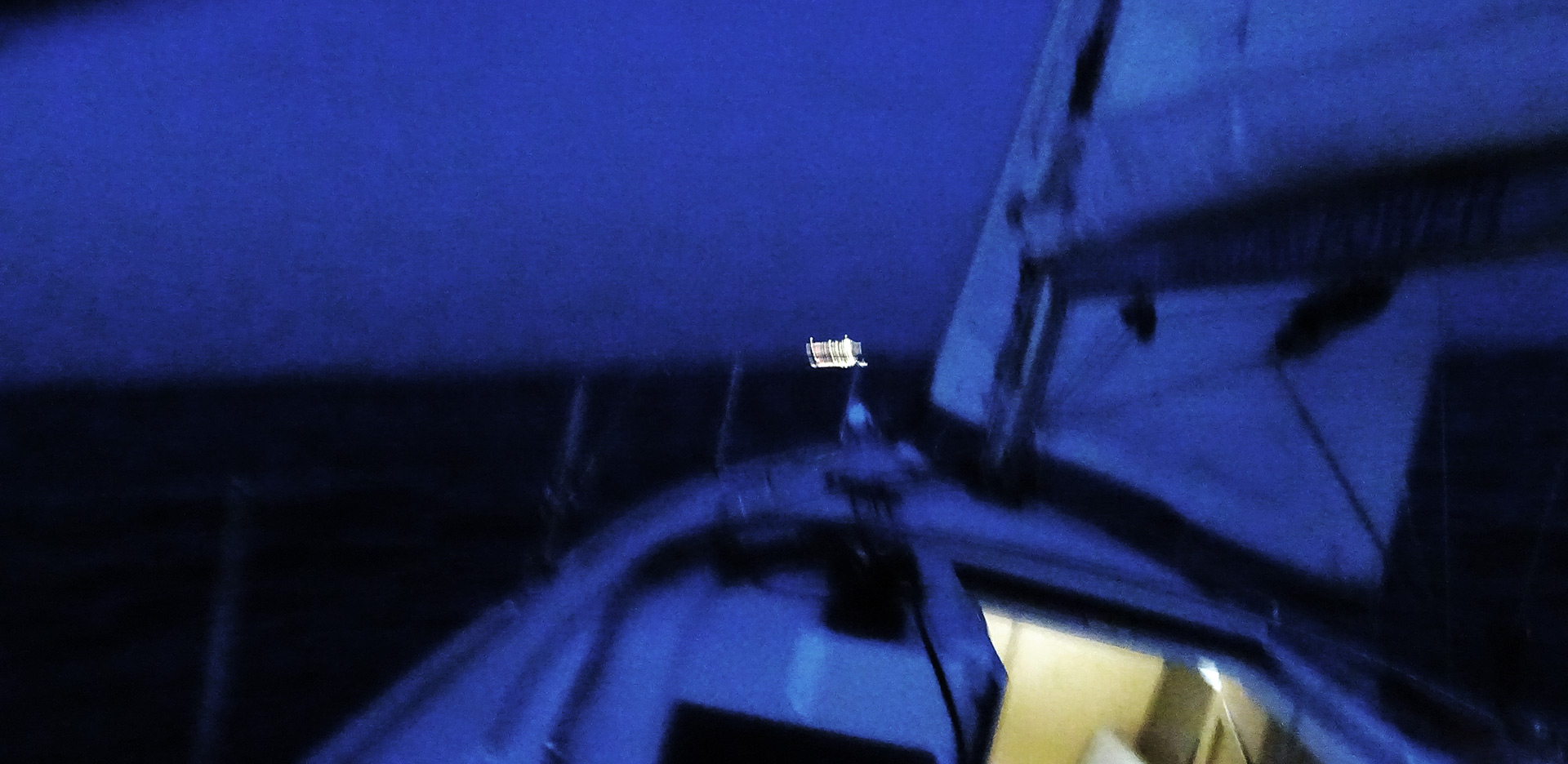
We were just 2 or 3 miles off of Gedser port and it was well after midnight that day. Some hours earlier when I decided to have the boat landing for the night I was throwing a joke that “concerning our luck of today we will meet a ferry right at the moment when we are about to enter the narrow fairway to the harbour.” And so it happened: Lucky as we were, the last ferry from Germany came screaming by from our starboard side with 18 knots and, from my past approaches to Gedser I knew, these big ships have of course right of way. And they will take it no matter what. So I tacked, the boat was doing 6.5 to well over 7 knots at this moment, we were under full Genoa and in the first reef with main. A nice wind was blowing hard. Best sailing weather, but our moods were a bit down that moment.
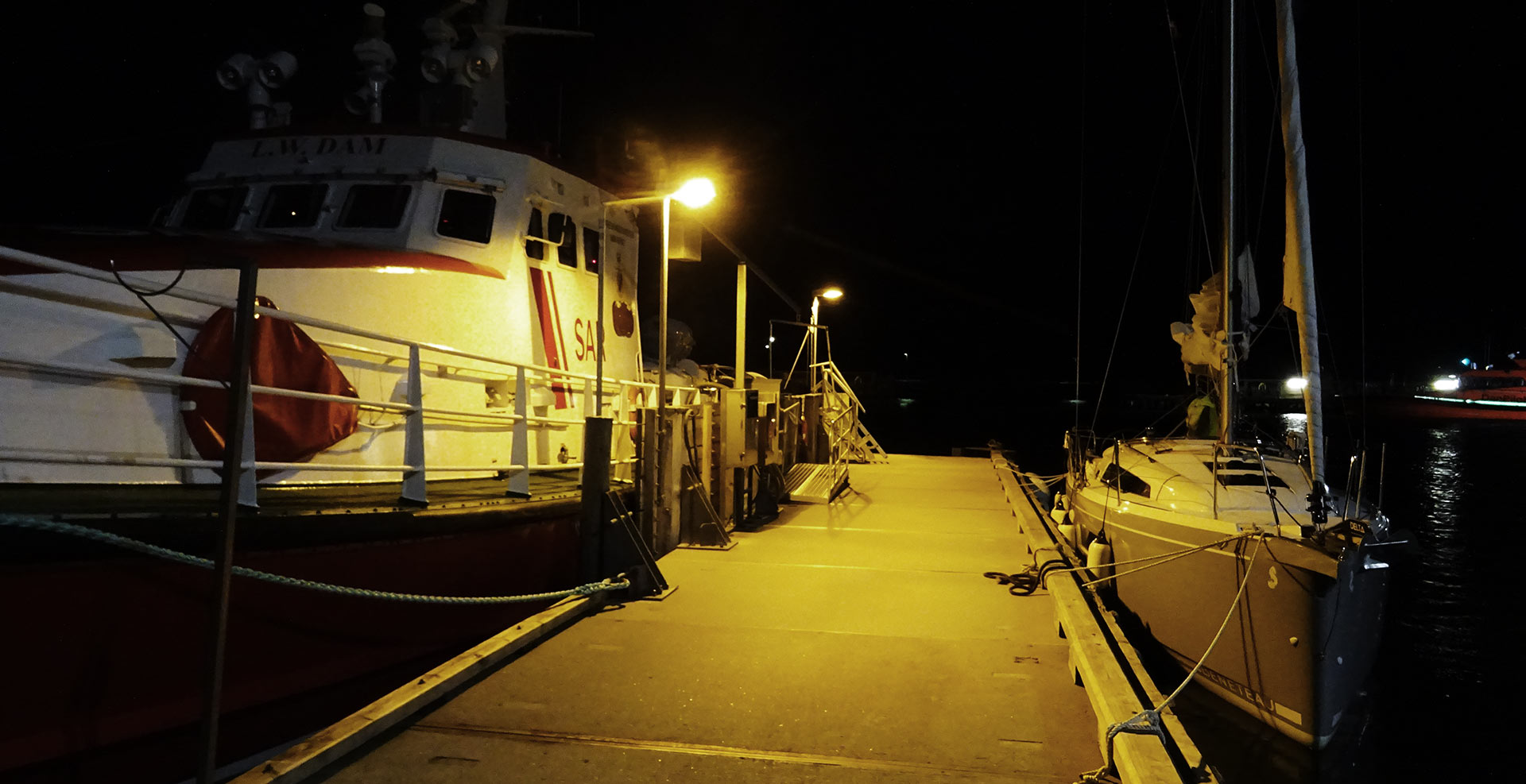
The ferry went past quickly and we tacked back to port side bow. I sailed our Beneteau Oceanis 30.1 for another quarter of an hour and waited until we entered the fairway to the harbour. Taking down the sails was a no-brainer and went fine, concerning the fact that there barely was any light available (later more on that) and the boat was even more rocking now that the stabilizing factor of the sails was taken away. At one a.m. the boat was moored safely next to an SAR-cruiser in the fisherman´s harbour of Gedser – an approach to the one mile away yacht harbour seemed to me rather dangerous under these conditions. Twelve hours of sailing ended, an even longer first day of my Sweden Sailing trip came to a conclusion – we both fell into our bunks. Tired. Exhausted. But let´s rewind here …
A flashback: Stowage in the Oceanis 30.1
The day before we left the adventure started. After making ready the boat (read it here) I wrote a long list of which provisions I should acquire. I love cooking aboard and was looking forward to two weeks of culinary escapades on the boat. For me, living off of stuff stored aboard is always like camping on the water. And I love camping. So here´s the shopping list … and off I went to Hamburg´s METRO-station, a B2B-shopping paradise for restaurants and professionals.
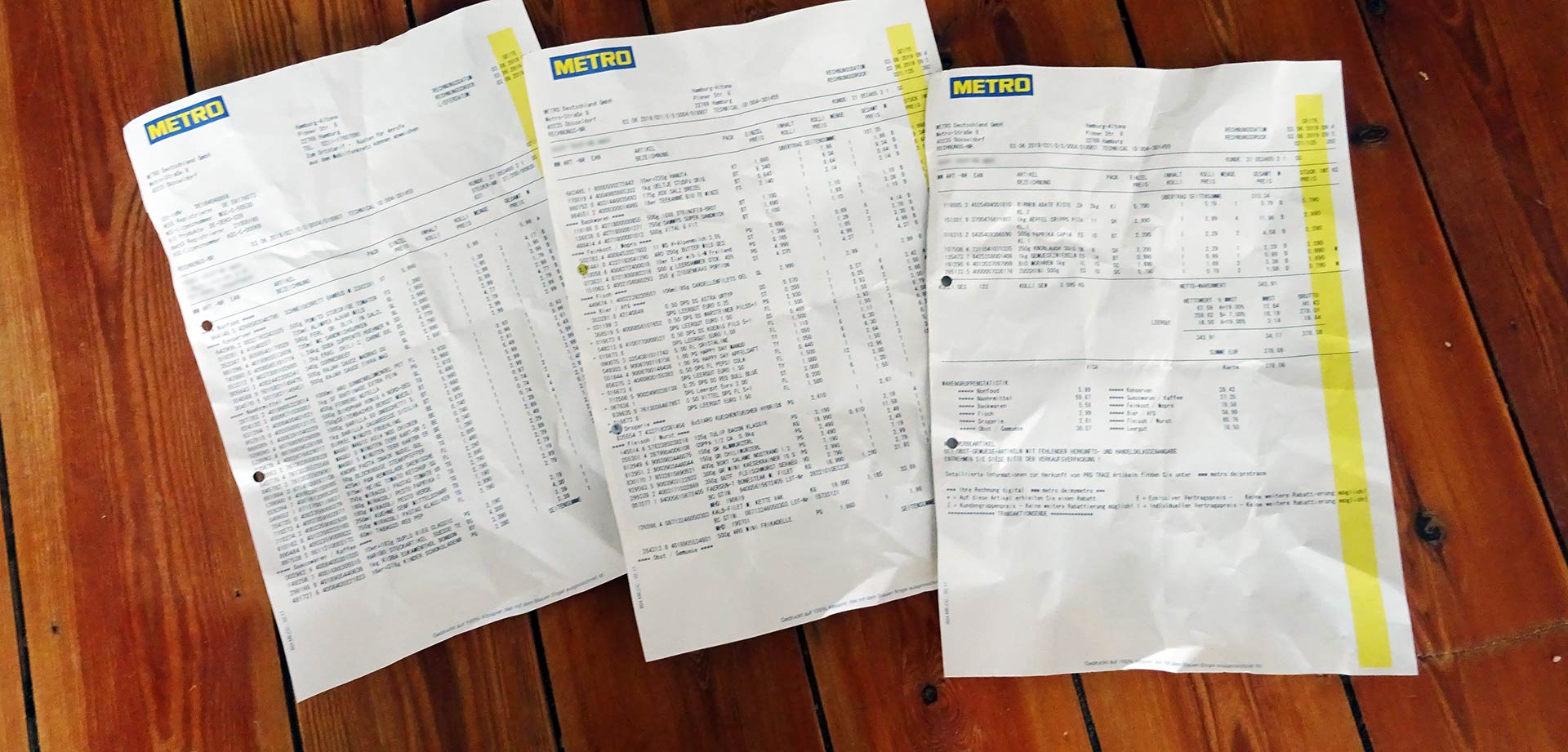
In the end, a fully laden shopping cart and some 400 Euros spent filled the first entry to the boat´s cash list and I wasn´t so sure anymore if this pile of food and drinks wasn´t too much for two persons. But I´ve calculated the list twice and it should fit (it did very well, I just over calculated the drinks and we had to leave some 8 litres of juice in Sweden). Among other things I´ve bought 70 litres of drinking water, 15 litres of beer (Sweden is a very expensive country when it comes to beer drinking), five loafs of bread, one half of an Italian Prosciutto, loads of bacon, vice versa of a Salami, a German ham sausage, a quarter of a cheese (Edamer-style and goat cheese), loads of sweets, Red Bull (for the night watches), coffee, tea and some fresh vegetables like onions, carrots, red peppers.
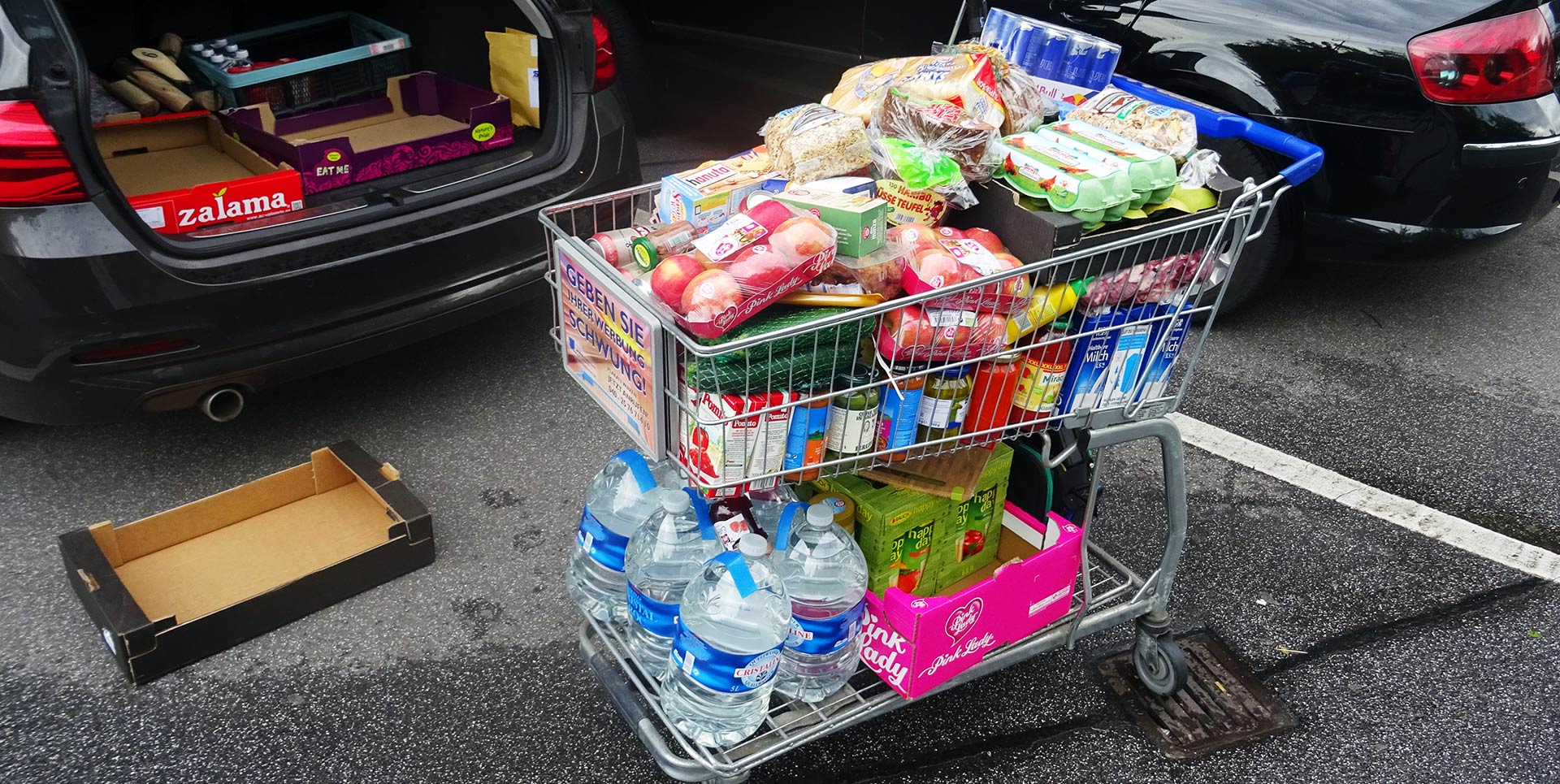
When I was hauling the yield to the boat in the afternoon the whole cockpit was overly stuffed with provisions. Some of my neighbouring skippers where wondering how long and where I was planning to sail as they couldn´t trust their eyes: “Where do you want to stow away that stuff?”, they asked, not really believing that I would be able to have it packed to the 30-feet yacht. Well, I was going to be successful, of course and so I began loading the boat. As ship master from previous trips I´ve learned that some things cannot packed to others. Some need it dry, some like it in daylight, some like darkness. Fresh things to be piled on top, canned and processed food below. It took me more than 2 hours but in the end I did have a system and the boat was ready.
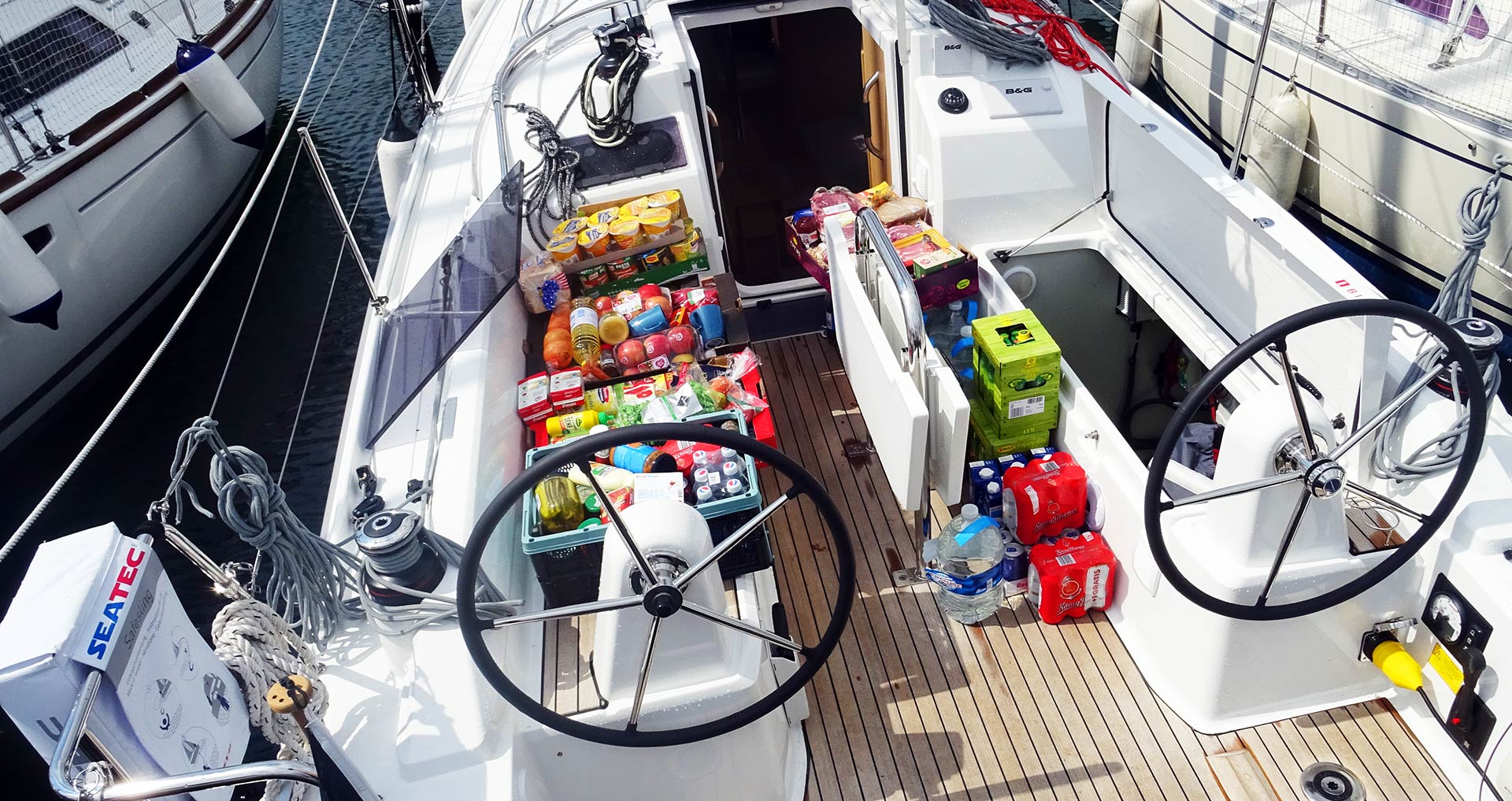
The Beneteau company was trusting me that prototype of their latest boat to be sailed to Sweden where there would be further sailing tests and a photo shooting. So I was willing to repay them for their trust in me as a skipper and have the boat delivered in time and in one piece. One of my premises was to get a broad and intimate insight in how the boat is performing – not just sailing wise but also as a platform for people to spend their holidays with the yacht. Stowage is a huge thing in boating so this was a crucial first learning.
Surprisingly large volume in the boat
Having seen the boat previously only on boat shows I´ve already read some comments in yachting magazines mocking the small volume of stowage especially when it comes to provisions and the galley. Well, I can now say: It is all no problem at all! I was able to have the boat fitted with everything a 2-person crew needs for two full weeks of sailing. That said, it includes of course plates, forks, knives, pots, pans, salt, sugar, spices and cooking utensils as well as the provisions.

In the galley itself I placed the “dry” stuff and was putting the provisions under the seating cushions in the salon. Most of the drinks and fresh water was put in the large – no, in the huge – locker outside of the boat (with still having enough space for spare sails, the Gennaker and tools and spare parts!)
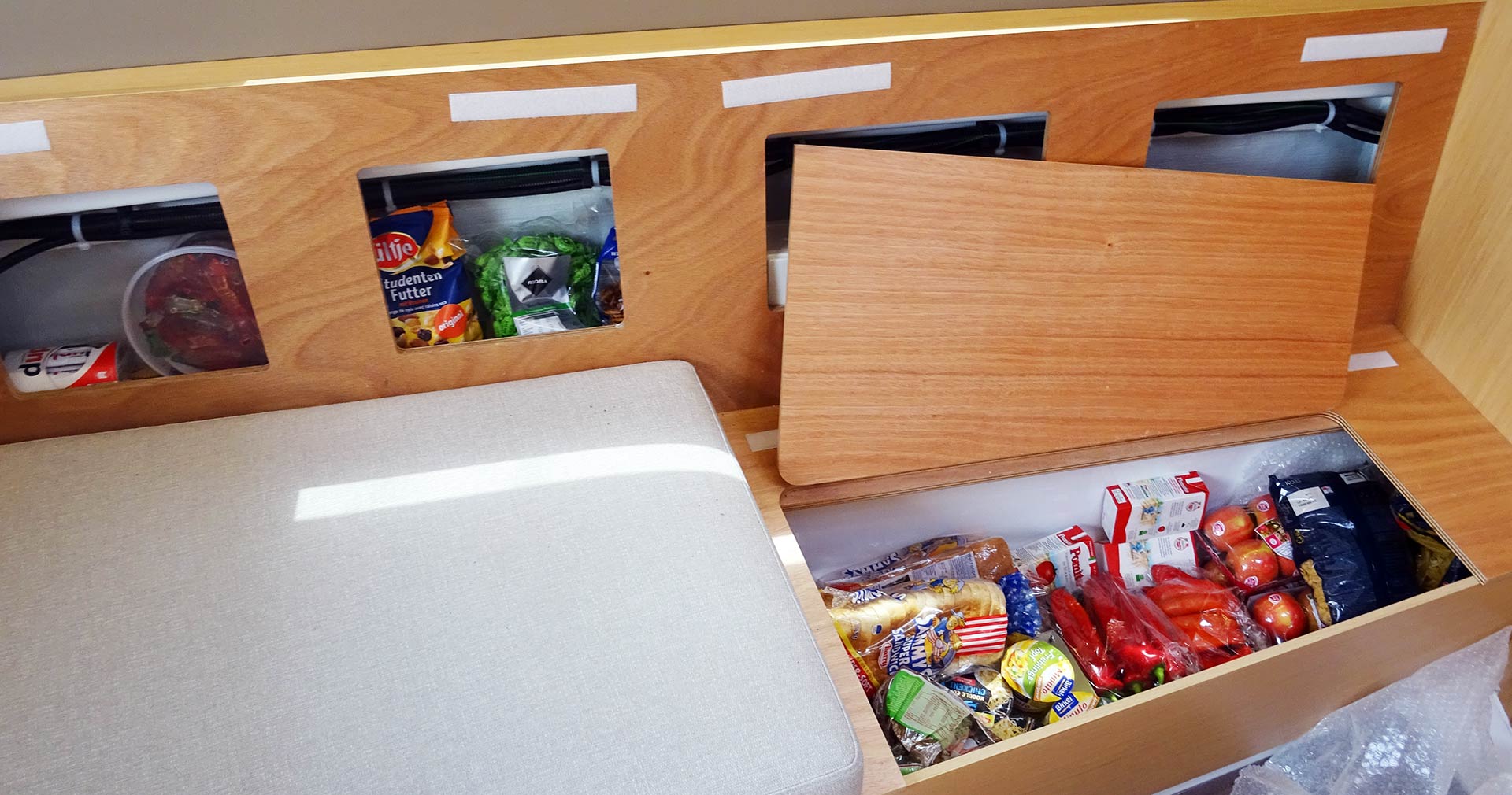
I stowed it away utilizing a system: Everything had it´s designated place and when for example one bag of noodles was used up everybody knew where to look for a new bag. In fact, I try to have this system applied to every boat I am on. For example, the sweets-locker is called “Aldi Süd” because on my own boat the pre-owners told me that they always have their chocolates and gums in a designated locker on port side behind the seating cushion. So, when I am captain, you will always find your sweet stuff in “Aldi Süd” on port side in the salon.
Welcoming the crew aboard
On the very day of departure my crew arrived. Well, calling it a crew is a bit oversized, because it was just one another man joining me. Martin May, now a friend, may be known for his unforgettable work in Germany´s blockbuster “Das Boot”. He loves sailing and this is how I got to know him during a VIP-regatta in Croatia last year. Martin was eagerly joining me, looking forward to two weeks of absolute freedom on the water without any professional appointments to keep.
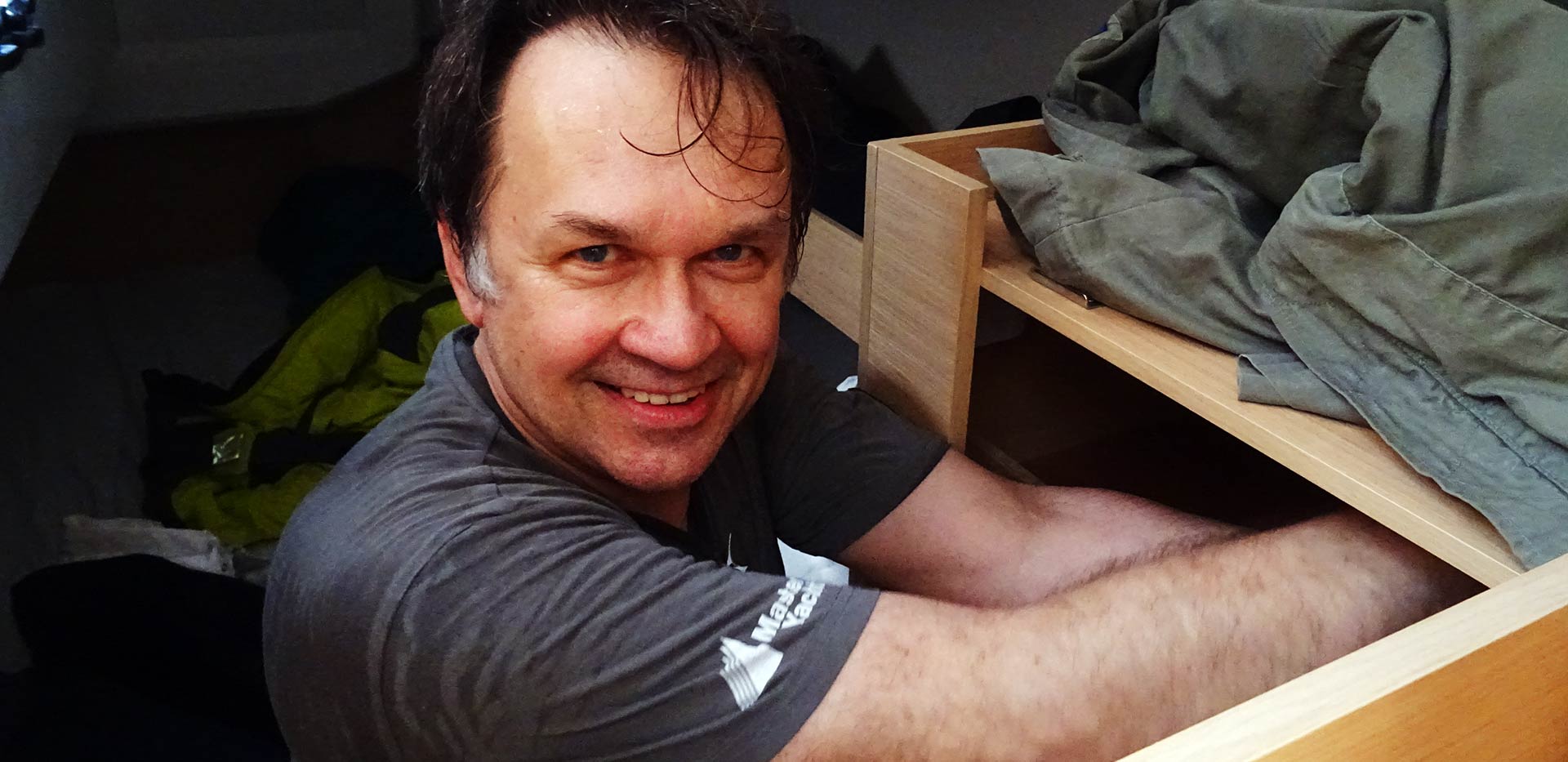
When he was throwing his bag aboard the boat was readily equipped with everything so there wasn´t any hustle. He chose to get the aft cabin which I was advertising to him as “offering far more berthing space but less on the cupboards”. So I was to get the fore cabin. There was less space on the mattrasses but even more in the closets. We happily accepted Beneteau´s offer to wear their softshell and caps and got professional live jackets from market leader Secumar.

It took us another hour to move into our cabins and have contents of our duffel bags packed into the closets. We sat down in the salon and I went through the mandatory list of safety measures, general behaviour underway and the whole skipper´s briefing. Martin was eagerly listening and asking the right questions. Now that the boat was ready, temperatures were rising and the clock was ticking towards noon, it was time to casting off and finally drop all lines.
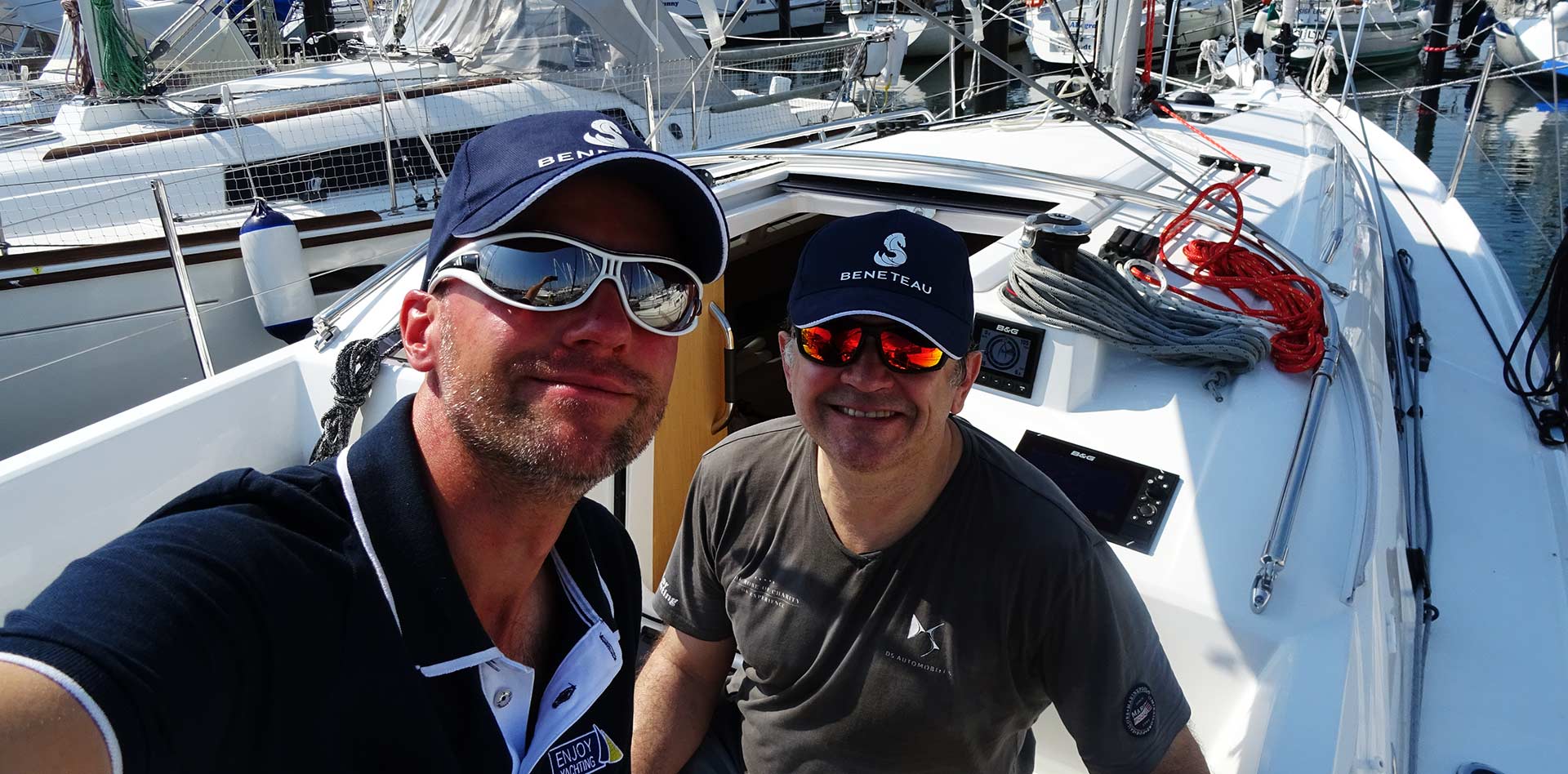
Which we did. We took our “leaving”-picture and I started the engine. What did we expect? I think we were full of high expectations. First of all, for me there were two weeks of free sailing ahead. Again with a minimum crew, which I liked, and no real pre-determined route to follow. I was keen on just sailing. Just bring up the canvas, put it int the wind and have the boat pushed. I wasn´t expecting too much of details because I knew – if there is a plan, the first thing that gets dropped is the plan. And right so it went, just minutes after we had finally left the marina.
A slow start
Well, all the euphoria was quickly dissolving, to be honest. Quoting the logbook which for 11.15 a.m. that day states: “Very light winds from 040 degrees, full canvas up, just 2 to 3 knots – merely drifting.” That´s like hitting the gas-pedal in the fully laden car en-route to the holiday and hitting a traffic jam right after the driveway to the freeway. The boat heeled quite a bit and yes, after trimming I managed to squeeze out some 3.5 to 4 knots, but excitement looks different, I should say.
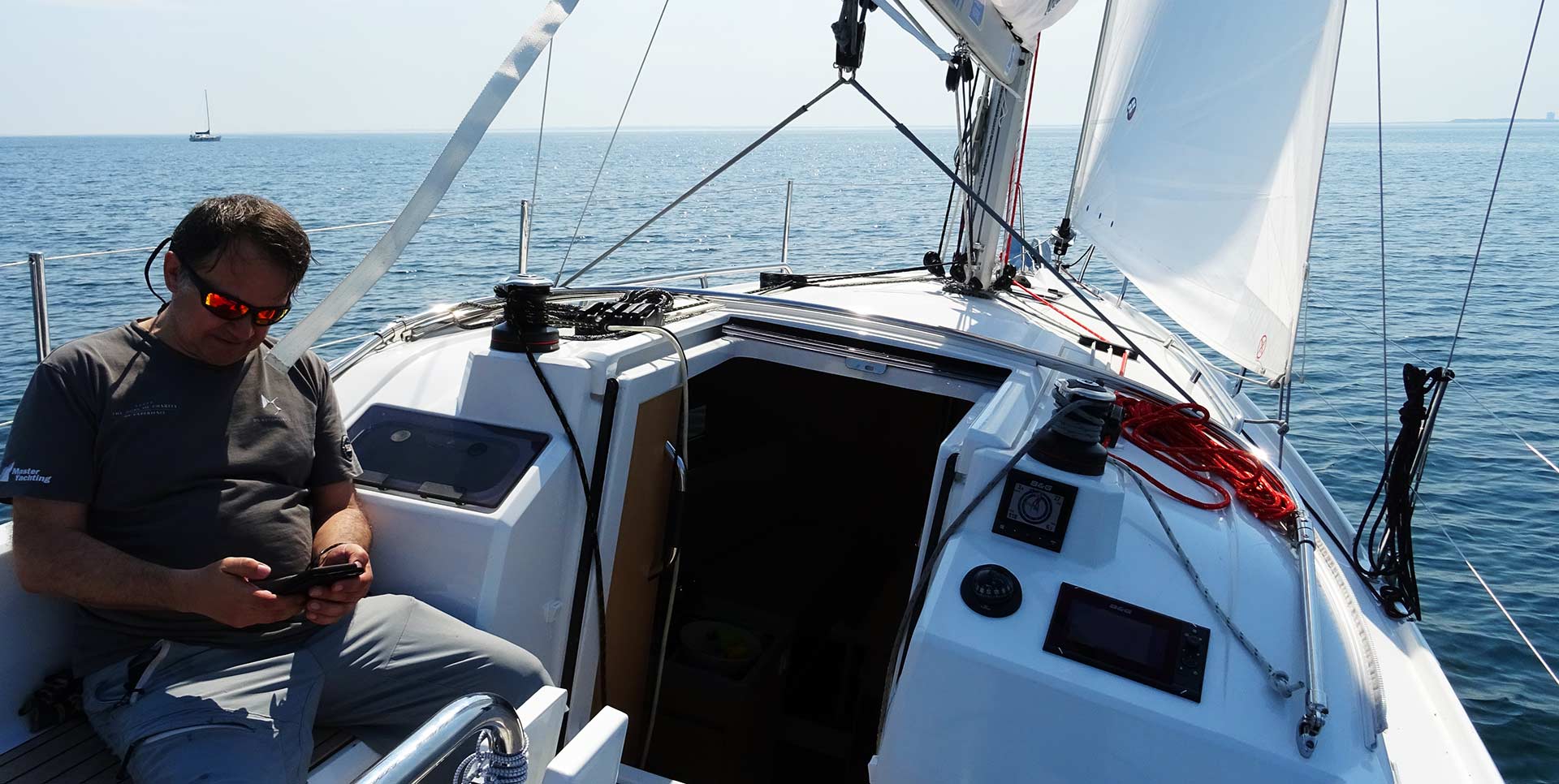
Martin used that slow start to work a bit. He is a busy dubbing director and two weeks off means a lot for self-employed people especially in the show business. He was on his phone, not really part of the crew yet, organizing stuff and talking to people. I for my part used the time to gather some latest weather checks and prepare a piece of paper with time and expected direction and strength of the wind – something I would later be relying on.
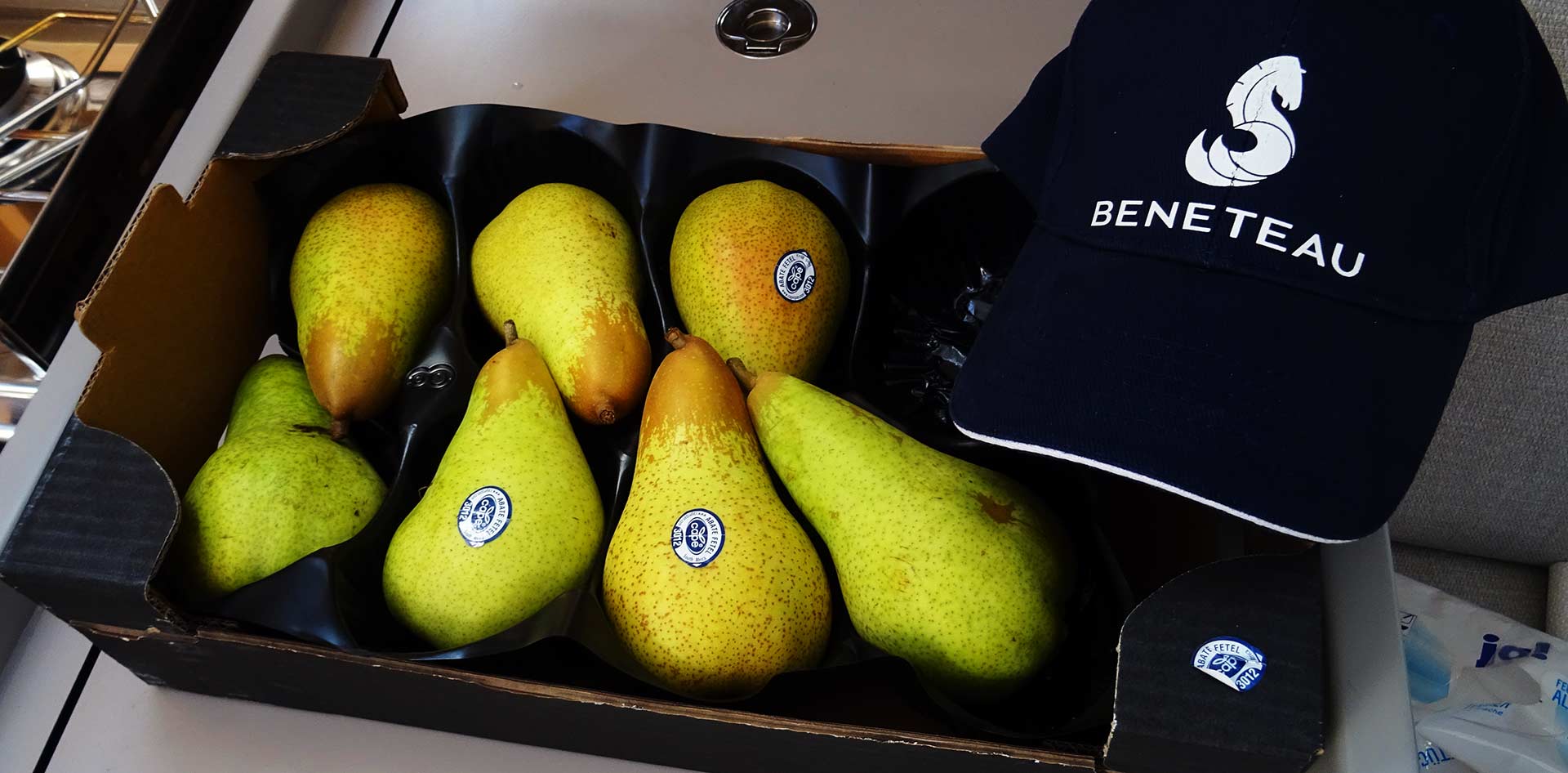
Let´s go down, I thought, and prepare a decent meal. The start to this journey was kind of hasty – that’s the usual thing that happens when I go on a long sailing journey – and my stomach was aching. So I went down and plundered the rich provisions of my boat: First a big tasty pear went down my throat, later, when Martin announced that he was hungry too, I prepared the first Klappstulle of the trip which we devoured with pleasure.
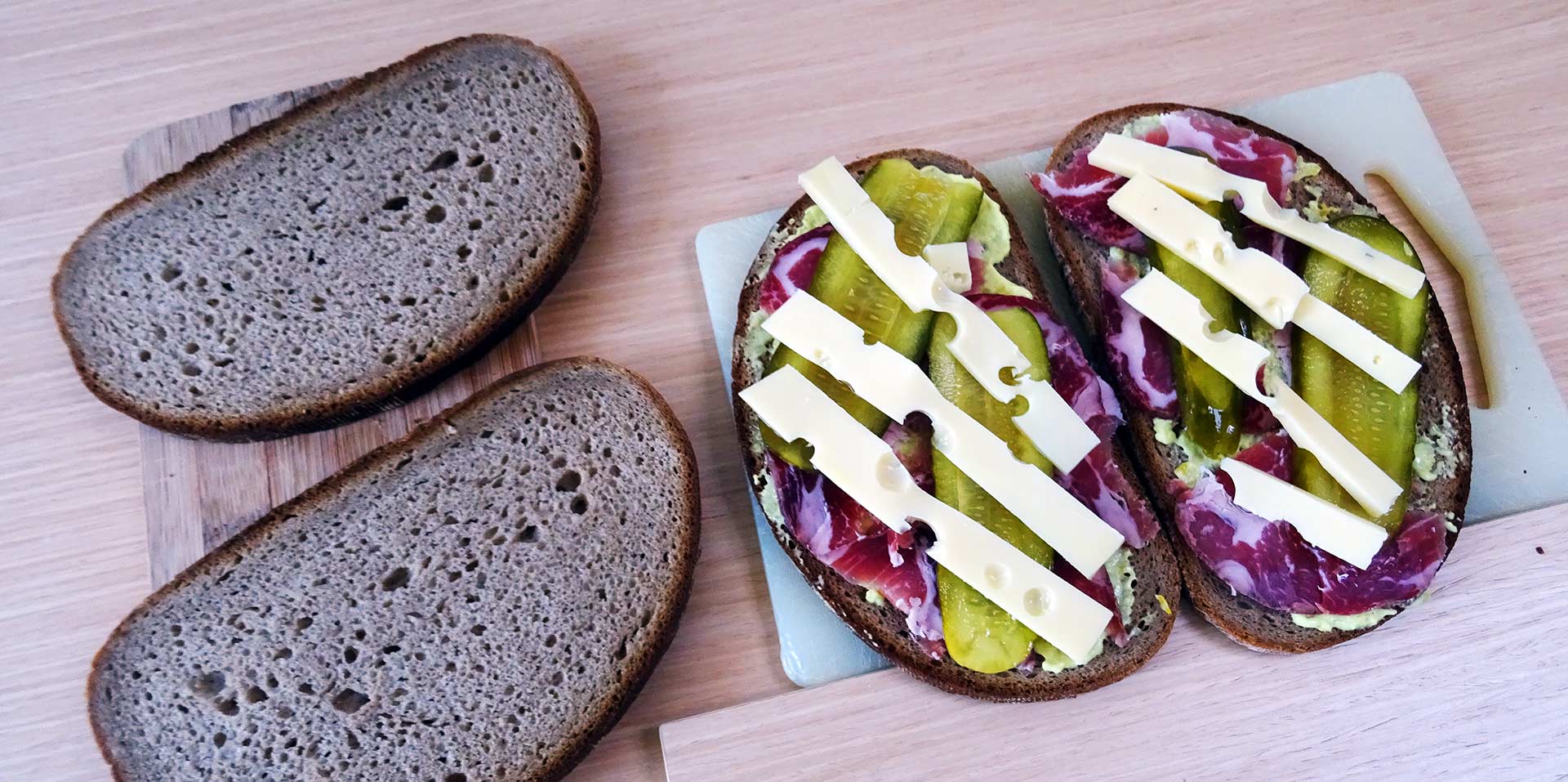
It took us hours, three hours, to slowly let the land disappear behind us. It was a bit disappointing to still having the all-too familiar landmarks in sight, such as the big amusement park and some chimneys. It didn´t quite felt like a big sailing trip, we still could see our homes! But then wind began to strengthen and the boat gradually but safely sprang to life. The logbook was commenting this with rejoice.

With wind speeds now regularly exceeding 10 knots true, that was what the boat was needing! She began to heel significantly and the slow light murmur of water at the transom was replaced by a furious gurgling of our stern wave. 6 knots and more! Martin put away his phone quickly and I went to the helm – now we are talking business!
Finally: Off she goes!
And how nicely she was sailing! The autopilot didn´t had any problem holding the due course. That´s because of the nicely balanced hull and distribution of forces from rigging and appendages as well due to the double rudder configuration, I would say. When I was taking over the helm from the machine, I sensed that the boat was giving me nice feedback – even though it had a cable pulled wheel steering – and reacted at an instant to my input.
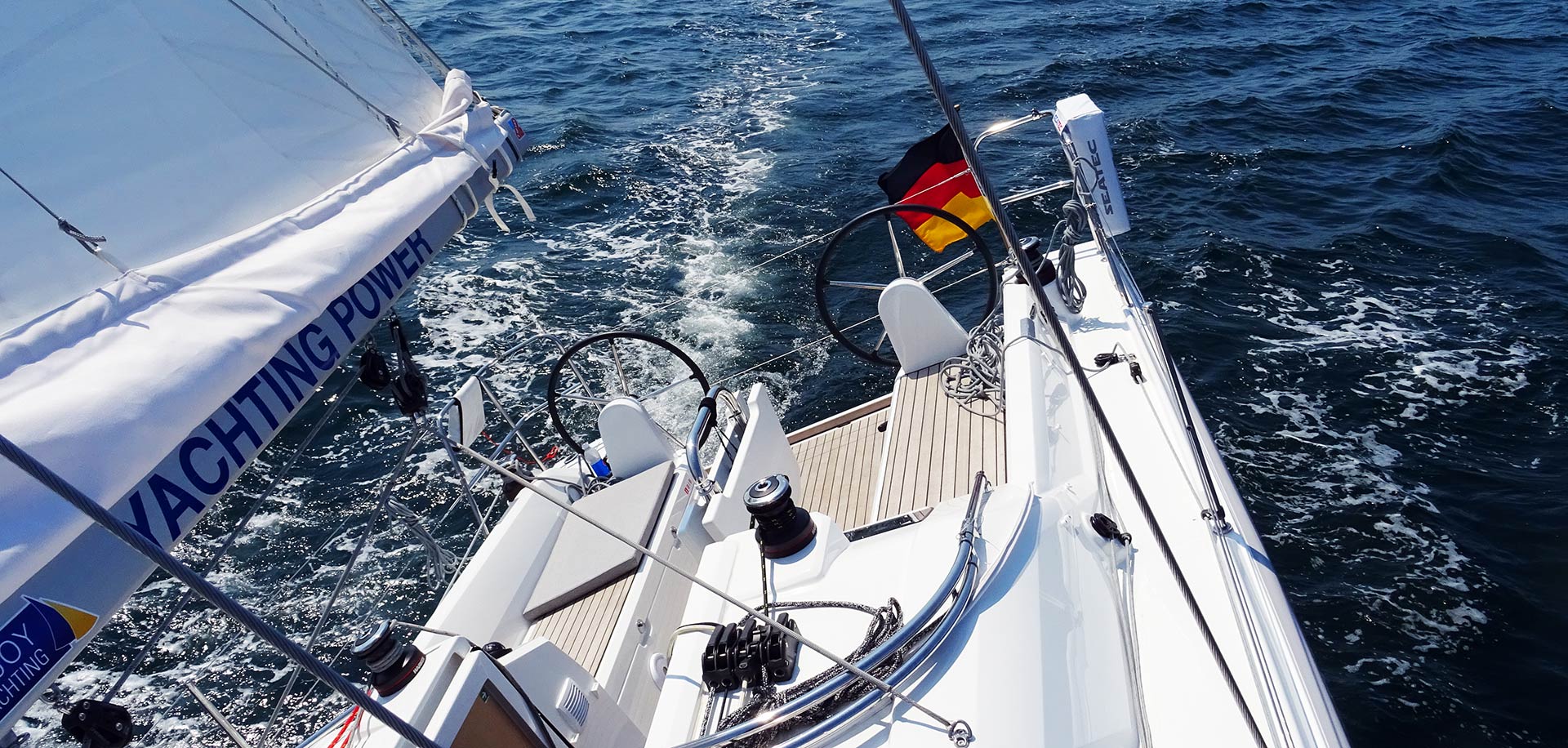
The leeward rudder was immersed in the water fully and I could see it steering the boat and slicing through the water whereas the windward rudder due to the heel of the boat came out of the water. Not fully as the tip was still occasionally submerged, but the concept was working. As the wind was blowing directly from the direction in which we were heading, I had to be tacking. So after four hours on starboard tack we went about, sailed swiftly for another 5 miles or so and tacked for another time: The Luebeck Bay was now behind us and we entered open Baltic waters – course due East!
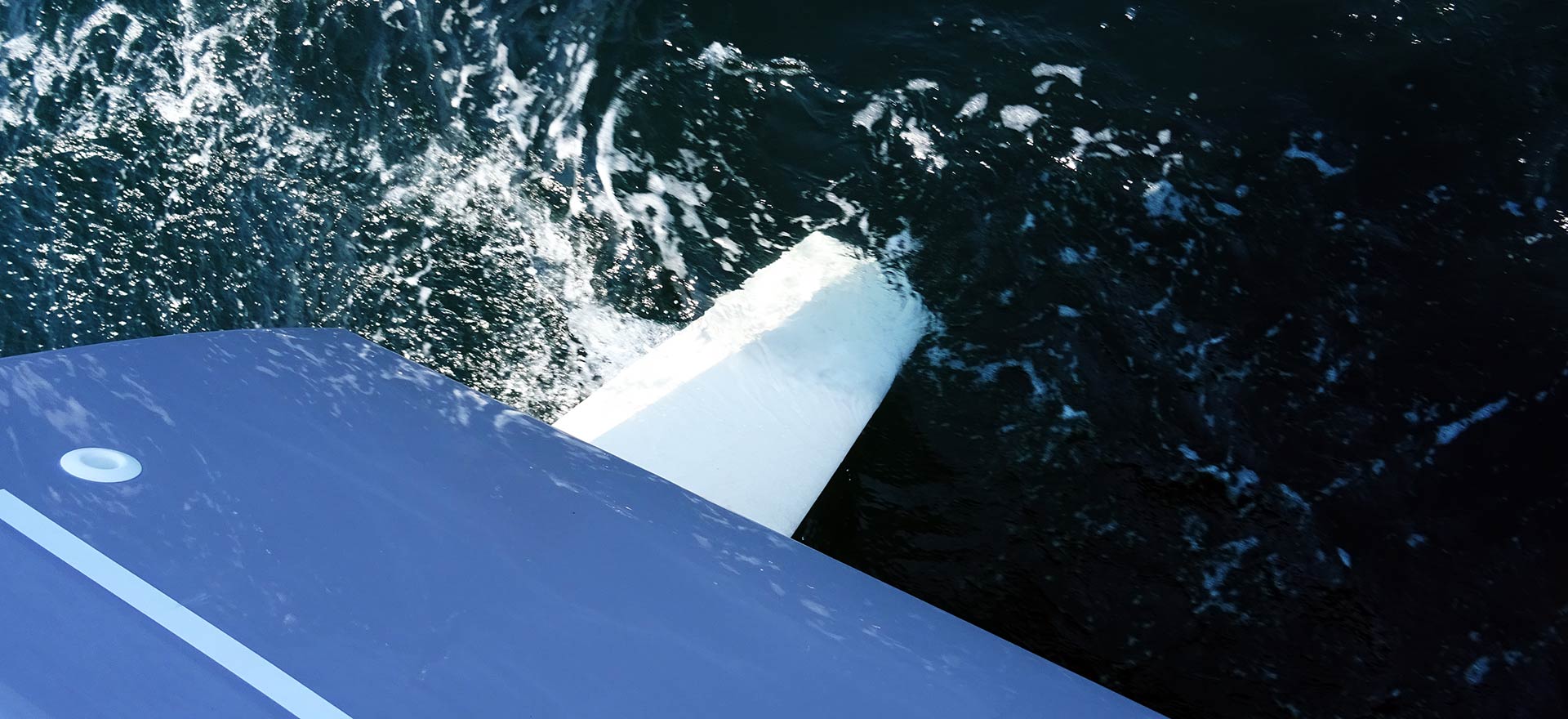
After having crossed the ferry lanes the sea became empty again. I was happy when wind wasn´t easing and we could maintain the full canvas set. The boat was storming: With speeds now regularly exceeding 7 knots over ground I was thrilled. When I was planning the trip I was calculating with an average of 5 knots. Now, with the Oceanis 30.1 being easily faster than this in reasonable winds I was full of hope that we maybe might be able to reach our sailing area much faster.
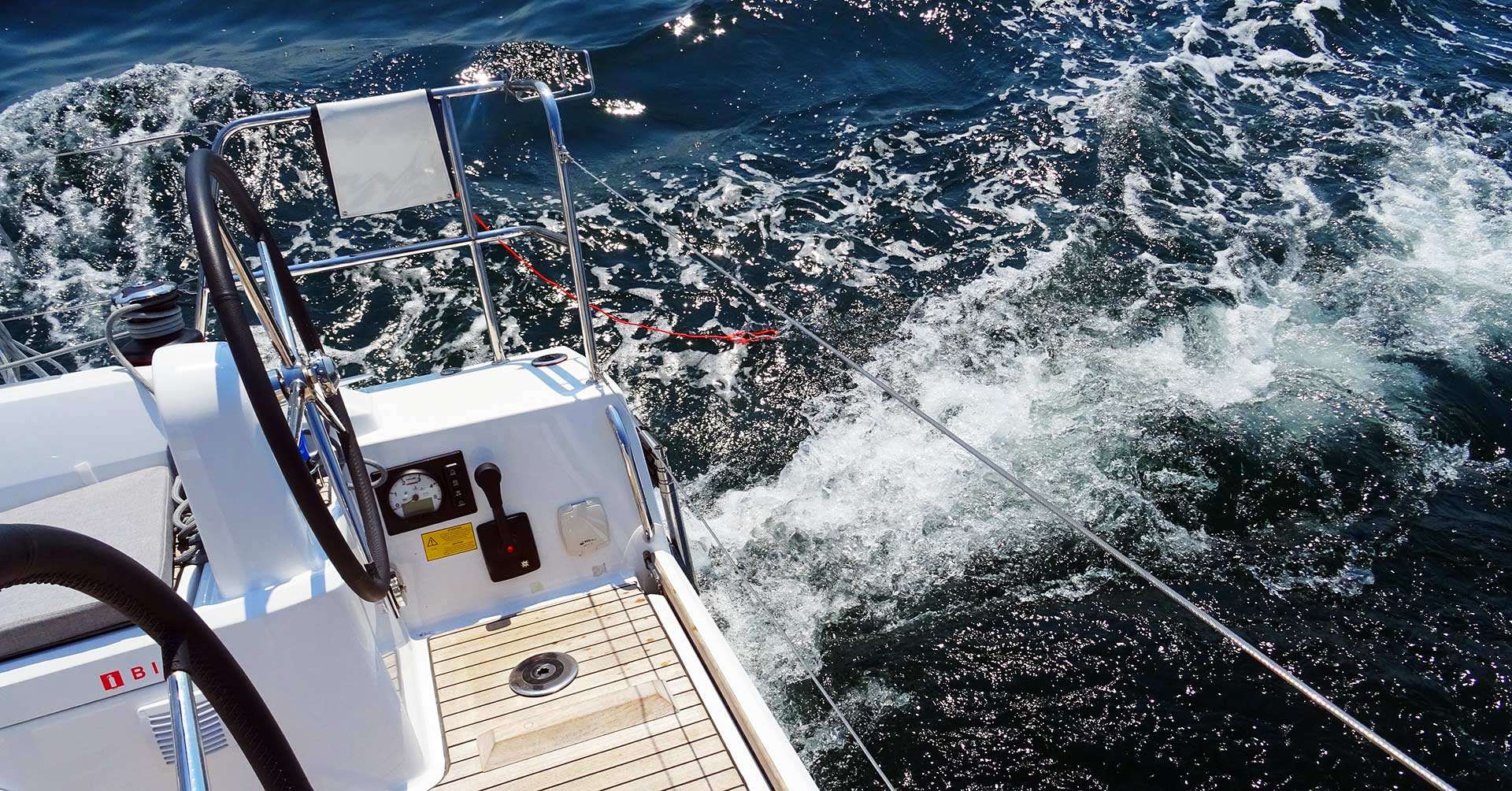
The plan was to sail day and night for 35 hours to reach the island of Bornholm. There I was planning to stay for 2 days, mostly because Martin has never been on that Danish island and I wanted to show him this precious spot. Then I wanted to sail for another long leg for 3 days to reach the island of Gotland, which was my childhood dream. Now with our small boat being that fast that easy this dream seemed to be coming true. Martin was slowly arriving at the scene with his phone now turned off and his job finally being left on dry land – a land that was falling behind us in the white mist of a hot summer´s day.
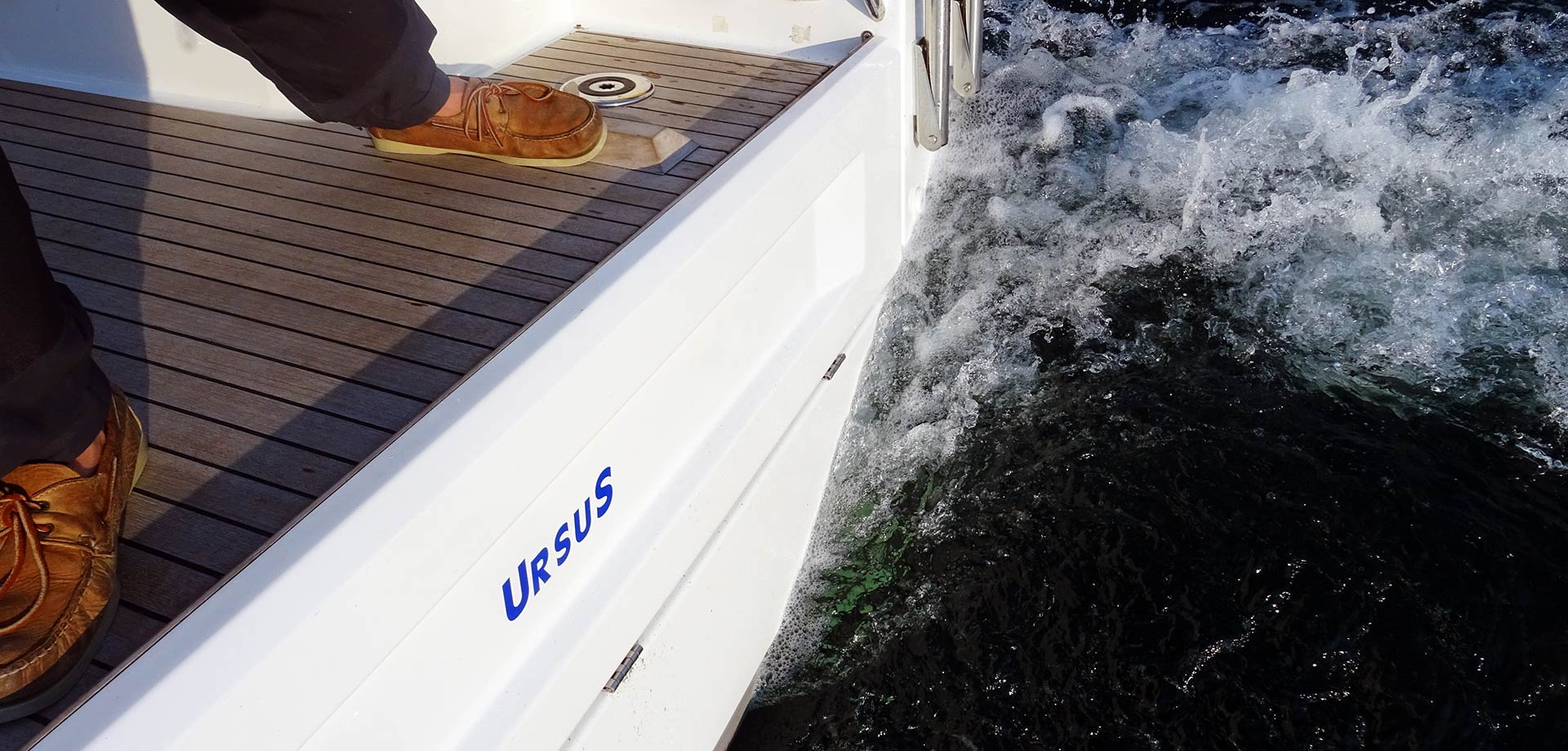
You remember my struggle to find a proper name for the boat? I went for URSUS which I though was best suiting. URSUS means “the one who is strong like a bear”, which I think is funny concerning the small size of the boat on the one hand and nevertheless her strong potential. A potential she was going to proof to us on numerous occasions throughout the trip to come for sure. So, URSUS was sailing very well when I set course to the first waypoint – Gedser. I didn´t intend to have the boat landed there but going East Gedser is always the first spot to sail by. Well, then it quickly changed everything.
A bitter setback
At first the back of my head noticed that on the plotter very little was going on, AIS-wise. We saw some vessels very close by but they quickly disappeared. We realized that something wasn´t working fine when Martin was asking some questions on AIS and I wanted to show him the answer, when I wondered: “Well, that’s odd: Normally this area is full of commercial traffic and we should see a multitude of freighters and ferries and cruise ships on a string striving towards the traffic separation scheme off Gedser …” And then it struck me: We simply didn´t had no VHF!
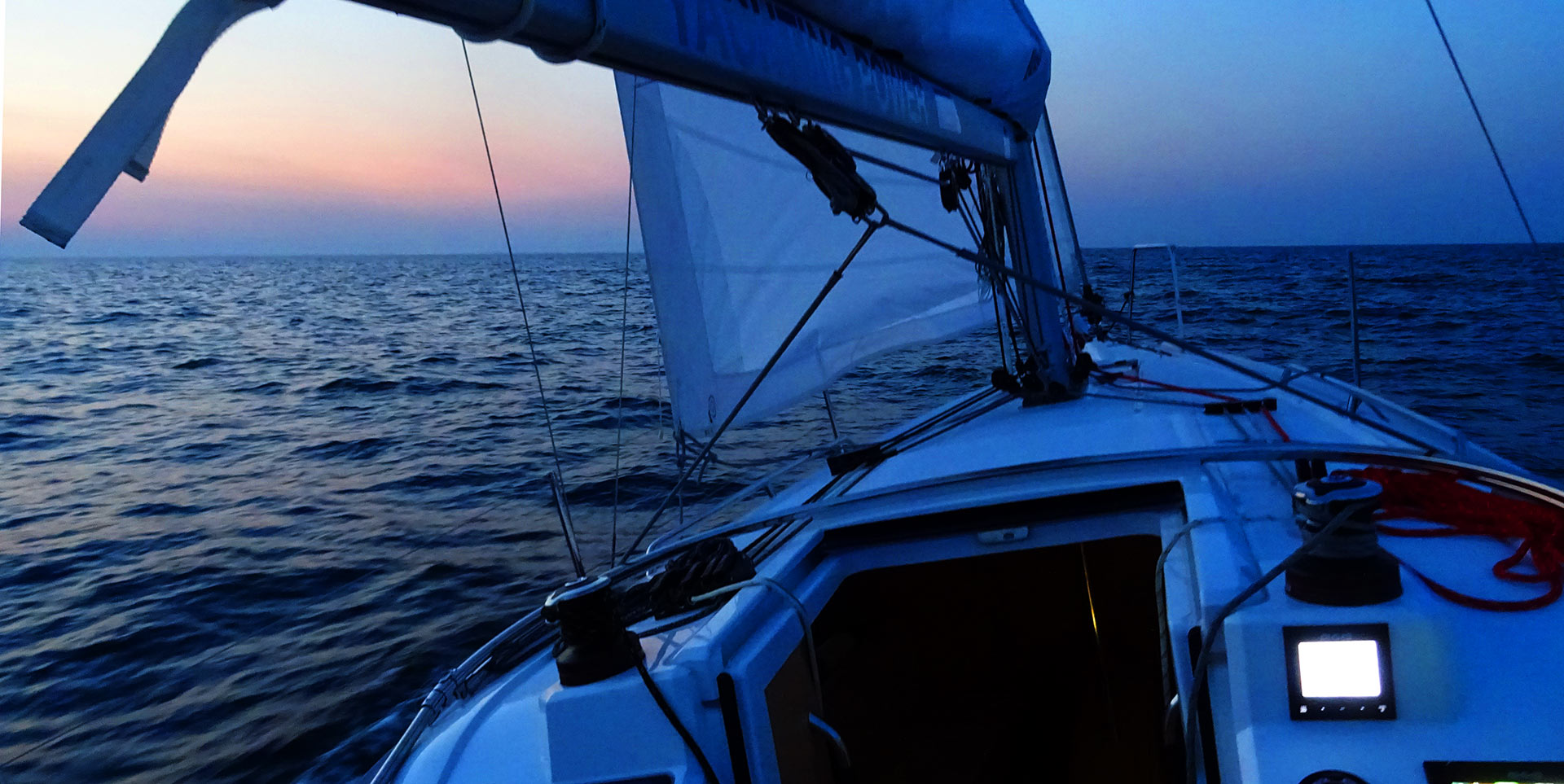
When this realization came through, my whole plan quickly deteriorated and crumbled. Sun was coming down and the daylight faded away, I went down to the panel and switched on the navigational lights of the boat. Of course, nothing happened. Thanks to the guys who were rigging the boat in the first place, they apparently didn´t connect the electric cables. So, without VHF you can sail, no problem, but without lights you simply cannot sail through the night! In addition, wind began to blow harder so that we exceeded 15 knots TWS regularly and had to take in a reef in the main.
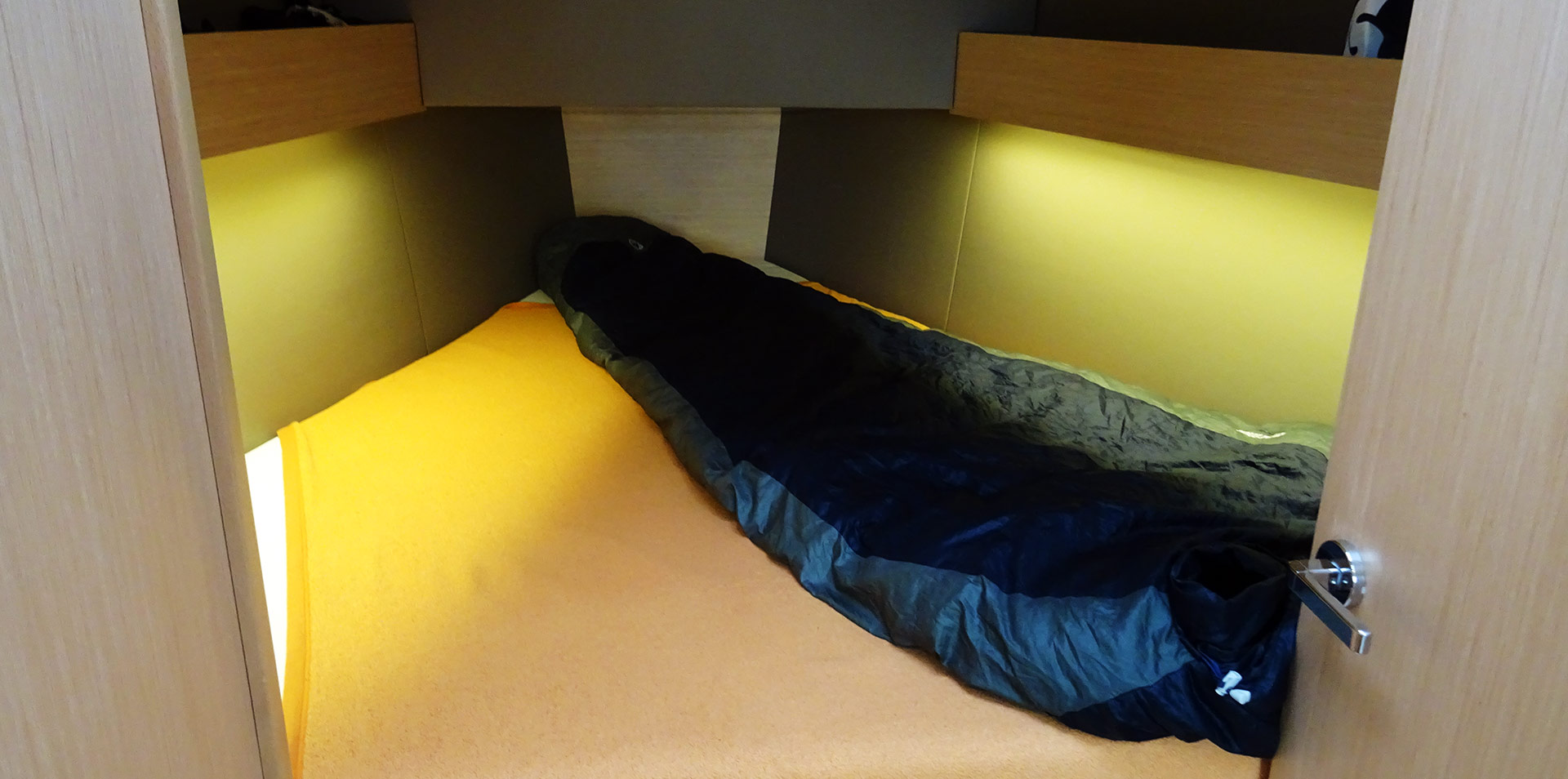
The rest is known: Just off Gedser harbour I decided to land the boat there. With ever increasing wind speeds and the knowledge that we didn´t had any lights in the mast top working, that was a truly awful experience. As the Gedser-Rostock-ferry approached, I slowed down not to bother the other Captain and, as I was putting it to Martin: “Not to trigger the other Captain to arrange a meeting for us with the Danish Coast Guard.” I didn´t knew exactly, but I knew that flying proper signals is an obligation for a boat. So, after two hours navigating the dark without lights I was able to tie up the boat in Gedser.
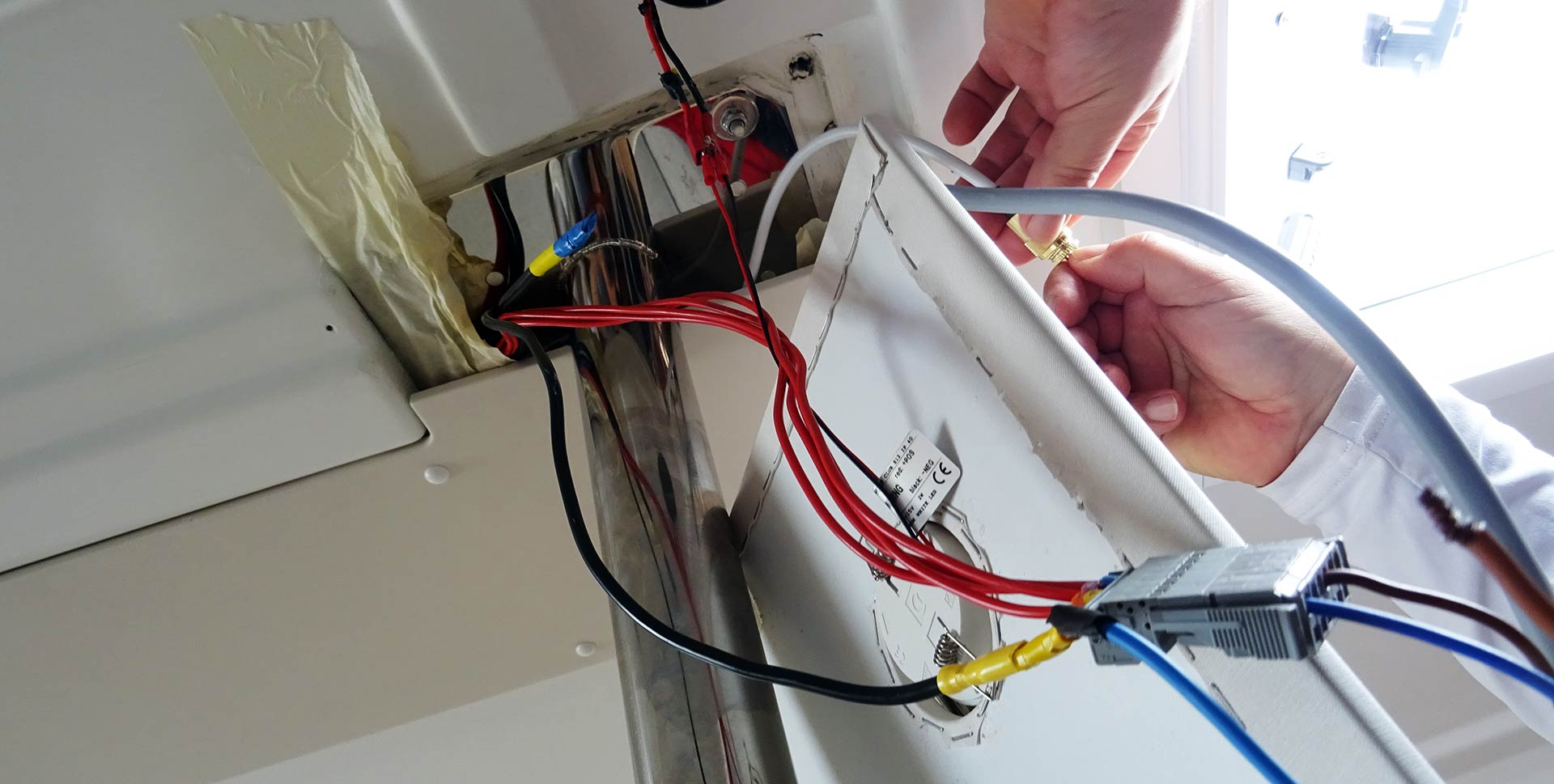
The next morning Martin took off the roofing panels near the mast-stand and our expectations – sadly – were confirmed. Not a single electric cable had been connected. At first I was cursing the rigging guys, a minute later, after thinking it through, I was cursing myself. The boat had been under my supervision for two weeks now and I was sailing her with clients – it has been my duty as skipper to check the proper function of all of her properties prior casting off. I did not, relying on the rigging crew. Now the shit has happened – Murphy´s Law. It happens during the most improper time: During nightfall in traffic at sea with increasing winds. I learned a lot that day, as a skipper and sailor and as an electrician. Because, it´s not that easy, connecting simple 12 Volt-cables: We had to search for the right connections by trial and error …
You may read all Sweden Sailing-articles by clicking on this hashtag #swedensailing
Also interesting:
A pretty perfect summer sailing
Weather routing and sailing trip planning
Right of way – in real life
